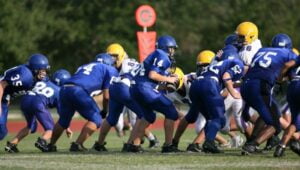Often wondered why one player was in a different volleyball uniform than their teammates? Volleyball is a team sport featuring six players from each side. Five team members wear same-colored jerseys whereas the sixth player wears a different-colored uniform. This sixth team member specializes in defending the volleyball by passing it to the defense lines and is allowed placement which seems necessary for the team. In volleyball, this sixth player or libero is officially required to wear contrasting jerseys to get distinguished from other team members.
If the team jersey is light bluish or off-white, a libero is required to put on darker shades so that the jury and spectators could easily identify them according to FIVB regulations. Similarly, if team jerseys are darker, liberos must wear light-colored uniforms. Moreover, liberos are permitted special privileges such as unlimited replacements whereas other teammates are only allowed six substitutions per game. Another exclusive rule for liberos is that they are not allowed to attack the ball over the nets or defend, or directly block when the ball’s height is over the nets which means they must pass the ball to fellow team members who are then allowed to throw the ball through the dividing net.
Introduction of Liberos in Volleyball
Liberos were first featured in International Volleyball as specialized back-row defenders in the 1998 FIVB World Championships. In the subsequent years, all the Volleyball organizations accepted the change because of the speed and action these specialist players carried in the game. In later seasons starting in 1999, USAV, NCAA, and NFHS adopted ‘libero laws’ for men’s and women’s volleyball ties.
The most extravagant aspect of liberos was differently colored jerseys from other team members. When the rules changed and the game picked up enormous pace post-1998, FIVB amended the rules to allow two liberos in a team, of which one player stays inside the court and the other on the sidelines for a replacement anytime during the game. The game evolved and so were the rules in upcoming tournaments. Libero regulations were first tested internationally in Olympics 2000 and are since part of the Olympics rules for indoor volleyball games.
What Differentiates Libero from their Team Members?
The introduction of liberos has added agility and efficiency to indoor volleyball games. There are several traits a libero must have to utilize their distinct position in favor of their team:
- They must be great passers
- Liberos ought to be swift and accurate in locating the opponents’ offenses to be there when the ball comes their way
- Liberos must have strong mental abilities to assess and defend the opponents’ attacking areas
- Liberos should pass back to the defense lines for a reattack instead of attacking themselves as a direct attack from liberos would result in penalty points to the team
Dos and Don’ts for Liberos
Liberos are officially the back-row defensive players according to Federation of International Volleyball rulebooks. However, they can move between the middle and back positions to defend the ball. Liberos are extremely supple as they swiftly move around throughout the receiving positions in the game. If you are a newcomer to volleyball, here are a few dos and don’ts that must be considered before applying for the specialist position:
Dos
- Liberos are allowed unlimited ‘replacements’ which are not counted in the team’s ‘substitution’ tally.
- The libero may replace the serving player to serve the ball in players’ circulation order.
- Liberos can be chosen as captains.
- If a libero is injured, he can be replaced by another libero. The injured libero cannot play for the remainder of the game in a specialist defender position. However, the libero can rejoin the team as a regular player in the ongoing match.
- Liberos can also be replaced for injured players if there is no replacement left on the team. They need to switch libero jerseys into regular colors to continue as regular players.
- The induction of liberos results in longer rallies, which make them instrumental in the game.
Don’ts
- Liberos must not block the incoming ball directly.
- Liberos must not serve in the game.
- Liberos are not allowed offenses, which means they cannot throw the ball across the dividing net.
- Liberos are allowed unlimited replacements except for when they are next in line for serving.
- If a team has two liberos, only one can be present on the floor at the same time.
- Liberos also cannot spike the ball or rotate it towards the front positions.






